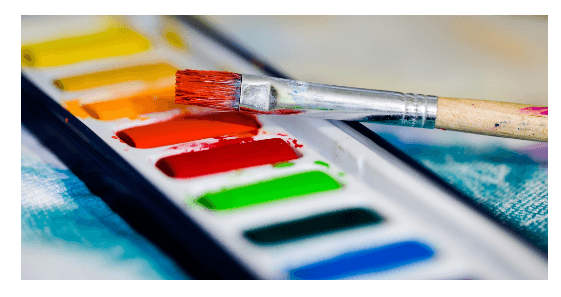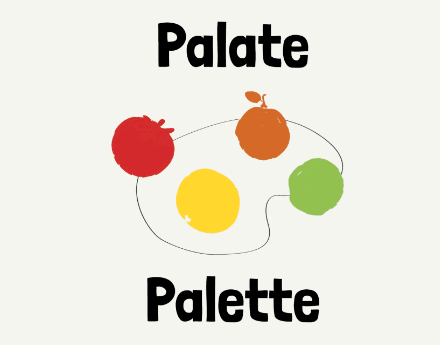Understanding Palate vs Palette: From Food to Artistry

Picture yourself pitching your groundbreaking restaurant chain to international investors. However, a small error in your presentation, such as using "palette" instead of "palate," could lead to confusion and doubts regarding your credibility.
Mastery of English, especially distinguishing between homophones like "palate" and "palette," is important for creating a positive and professional impression.
This post aims to look into the differences between these words, helping improve your spoken English.
What are Homophones?
Homophones are words that sound the same when pronounced but have different spellings and meanings. For example, 'pair' (two items) and 'pear' (a fruit); both sound the same but have different meanings.
Understanding homophones can greatly improve your English communication skills. Here are some common homophones Clapingo has covered in their blogs - there vs their, lier vs liar, principle vs principal, etc.
Now let's understand the two confusing homophones "palette" and "palate" in detail.
Introducing 'Palate' and 'Palette'
'Palate', a noun, is used in the context of taste or the roof of one's mouth. It's commonly used in phrases like 'a refined palate' or 'the chicken curry tickled my palate'.
Whereas, 'Palette' is also a noun that is commonly used in artistic fields. It refers to a thin board or slab on which an artist mixes paints and colours. An example could be, 'The artist cleaned his palette before starting a new painting'. Remember that both words are pronounced the same.
To help you understand better, take a look at this comparison table:
Word | Palate | Palette |
Definition | The roof of one's mouth. A person's ability to distinguish between and appreciate different flavours | A thin board with curved edges and a hole for the thumb, used by artists for holding and mixing paint. |
Part of Speech | Noun | Noun |
Usage Context | Cooking, Tasting | Art, Colour Schemes |
Example | Spices from India excited his palate. | The artist mixed colours on his palette |
Palate or Palette: How to Remember?

Remembering the difference between 'Palate' and 'Palette' can be tricky.
One helpful trick is connecting each word with something Indian that is familiar to you. Think of 'Palate' as 'Pani Puri Palate', as it's connected with taste and food.
And, think of 'Palette' as 'Peacock Palette', connecting it to colours and art, just like a peacock's beautiful feathers.
This method, known as mnemonic association, is a powerful memory technique. It involves linking new information to something familiar, increasing the chances of remembering it correctly.
Common Mistakes with 'Palate' and 'Palette':
Many English learners in India often confuse these two terms. Let's address some common mistakes:
Misuse in context: Sometimes learners use 'palette' when referring to taste or use of language (which should be 'palate'). For example, "She has a diverse palette for cuisines" should be corrected as "She has a diverse palate for cuisines."
Spelling confusion: It is common to accidentally switch the spellings of these two words.
Practical Exercises for Mastering 'Palate' and 'Palette' Usage
Now let's practice using 'palate' and 'palette' correctly.. Below are a few exercises to help.
1. Fill in the blanks with the right word - 'palate' or 'palette':
The artist mixed his colours on his _______.
Spicy food can overpower your _______.
Vibrant colours bring life to an artist's _______.
A wine taster needs a discerning _______.
2. Write sentences of your own using both 'palate' and 'palette'.
Answers:
palette, palate, palette, palate
How to Boost Your Professional Communication
Knowing English well, especially the difference between homophones like "palate" and "palette," can really improve your written communication. For example, if you're writing a business proposal for an international client, using the wrong word could make things confusing or even change what you mean.
Clapingo's personalized sessions aim to help you learn these English language details. This way, you can avoid mistakes, communicate more confidently, and make a better impression in your professional life. Take a quick demo to see why Clapingo is the best fit for you.
Final Thoughts
To wrap up:
'Palate' refers to the roof of your mouth and, more broadly, your sense of taste.
'Palette', on the other hand, is a term related to art, referring to the board an artist uses to mix their colours.
Learning these small details can really boost your confidence in speaking English. Clapingo helps you by letting you talk one-on-one with native speakers, which is a great way to learn. Keep going with Clapingo and achieve your goal of speaking English fluently and confidently.
FAQs
1. What is the difference between 'palate' and 'palette'?
'Palate' refers to the roof of the mouth in humans and other mammals, or a person's appreciative taste for food or drink. 'Palette' refers to a thin board or slab on which an artist mixes colours or the range of colours used by an artist.
2. Are 'palate' and 'palette' pronounced the same way?
Yes, as homophones, they are pronounced the same way despite having different meanings and spellings. This can be a challenge while learning English. It's important to understand their context to use them correctly.
3. When should I use 'palate' and when should I use 'palette'?
Use 'palate' when referring to taste or culinary matters: "The chef's dishes satisfied my palate". Use 'palette' when discussing art or colours: "The sunset displayed a beautiful palette of oranges and purples".
Comments
Your comment has been submitted successfully!